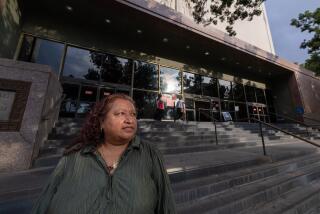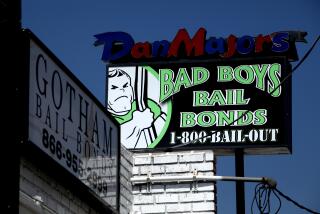Jury Service No-Shows Get the Word: No Excuses
- Share via
Some say they don’t have time, others aren’t scared of the repercussions, and the rest just don’t want to do it.
Whatever the reason, last year more than 1.1 million Los Angeles County residents did not respond to their jury summonses.
The Los Angeles County Superior Court has started tracking the no-shows, providing several opportunities for them to serve and finally making them appear in court or pay a fine.
“They’ve been lenient forever,” said Teresa Hoff, 43, who recently appeared before a judge to explain her absence. “But [now], they are sticking it to you. If you don’t send in anything, they are definitely going to go after you.”
During her sanction hearing, Hoff agreed to serve later this month. If she does so, the $150 fine imposed by the judge will be lifted.
The sanctions for failing to appear can be expensive. A judge can order prospective jurors to pay up to $250 for the first failure, up to $750 for the second and up to $1,500 for the third.
While 140 residents were on the sanctions hearing calendar along with Hoff on that recent Thursday, only 11 showed up.
Two of those agreed to serve, five were not qualified and four attended sanction hearings.
The absentees will receive letters from the court confirming the sanction, along with a demand for $250 from a collection agency. From January to May, the court sanctioned more than 22,000 prospective jurors, who were ordered to pay a total of more than $718,000.
“We’re not in the money-raising business here,” said Judge Alice C. Hill during the hearings for Hoff and three others. “My sole goal is to get jurors to serve.”
In 1999, the court launched the so-called one trial jury service, which allows jurors summoned for duty to be present for one day of jury selection and, if chosen, serve until a decision is reached.
In the past, the court system required jurors to appear for 10 days or for the duration of a trial.
Although the new system helped decrease the jury non-response rate -- which has dropped to 36% in fiscal year 2002 to 2003 from 50% in fiscal year 1997 to 1998 -- things still are not where they should be.
“We have heard from jurors saying, ‘It’s not right and it’s not fair we have to take that burden,’ ” said Gloria Gomez, director of juror services for the Superior Court. “When you consider this duty is a mandatory obligation, you can understand why people feel resentful that there are people out there who are not doing this.”
Those not showing up always have an excuse, Gomez said, like the man who said he could not serve because he had “old-timer’s disease,” the mother who had to drop off and pick up her 17-year-old child at the bus stop every day, or the resident who needed to fix his glasses before he could endure a trial.
Gomez pointed out that more than 30% of those called to serve do not meet the requirements because they are not citizens or they do not speak English. Still, she said, they must notify the court of their circumstances.
Hoff’s excuse: “I was overwhelmed.” The 43-year-old stay-at-home mother was already unemployed when her driver’s license was revoked. Then she received her jury summons. Hoff said she ignored it.
Prospective jurors have one year from receiving their first summons to respond to the court. After that time, they will receive a sanction summons, which explains the program and gives a new service date. If they do not respond to the white envelope with a bright orange box within 30 days, they receive a failure to appear notice.
After another 30 days without communication, the court sends an order to show cause, complete with a final day to appear for duty and a court date, just in case the individual does not show up.
“The urban legend that existed for years that ‘nothing happens if you just throw your summons away’ is no longer true,” said Presiding Superior Court Judge Robert A. Dukes.
“If we had everybody respond, a juror would only have to get a summons every three to four years.”
Hugh Sutherland, 46, says he understands the importance of serving. But a recent relocation and a medical disability prevented the Northridge resident from responding to his summons.
Even for someone like Sutherland, who says he does not mind performing his civic duty, the idea of a fine was “severe.”
“It was the fine that got my attention,” he said.
The court is willing to work with prospective jurors, Gomez said. Service can often be rescheduled to avoid workplace difficulties, she said.
In any case, she said, the court must hear from those summoned so it can make a determination.
As Hoff prepares for jury duty later this month, she says she’ll never ignore another summons. She’s even become a walking public announcement, telling friends to take those summonses seriously.
“I called everyone I knew and said, ‘If you have these, you should take care of it,’ ” Hoff said.
“Had I known the consequences, seriously, I would have gone.”
More to Read
Sign up for Essential California
The most important California stories and recommendations in your inbox every morning.
You may occasionally receive promotional content from the Los Angeles Times.










